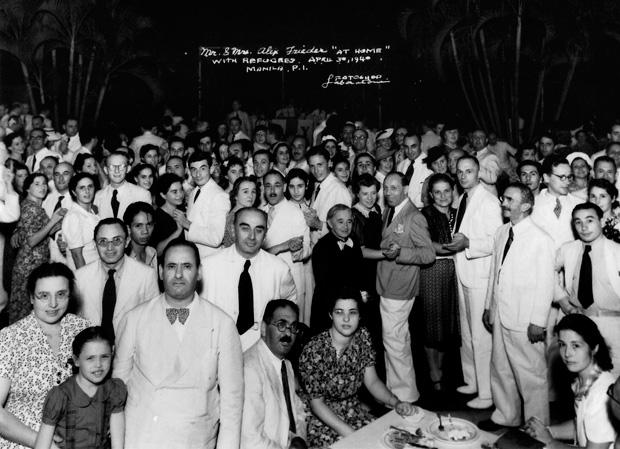A Holocaust rescue that remained little-known for years
Published March 26, 2014
The Holocaust Museum and Learning Center’s Sunday Film Series will highlight a fascinating but little-known story of the rescue of 1,300 Jews during the Holocaust — including one survivor who now lives in St. Louis — which brought them from Europe to the Philippines.
The documentary “Rescue in the Philippines: Refuge from the Holocaust,” recounts how five American Jewish brothers, businessmen who made cigars in Manilla, along with then-Army Col. Dwight Eisenhower, the first president of the Philippines Manuel Quezon, and the U.S. High Commissioner to the Philippines Paul McNutt, hatched a plan over a friendly poker game and cigars.
At the time, the Philippines were still under U.S. control but making a transition to independence. Eisenhower, then a colonel under the military commander, General MacArthur, had befriended Quezon, McNutt and the Frieders, whose cigar factory was a major employer in Manilla. The friends met for regular poker games.
“The group were friends and played poker and smoked cigars together in Manilla,” said Peggy Ellis, co-producer of the documentary and the granddaughter of Morris Frieder, one of five brothers. She and her cousin Barbara Sasser were instrumental in getting the documentary made.
Each of the friends in the group would play differing but essential roles. Quezon and McNutt handled political and diplomatic matters, the military facilitated transport and the Frieders provided the funding. But once the plan was hatched, the group still encountered obstacles. Fearful of too many refugees, or in some cases prompted by anti-Semitism, many countries had erected barriers to Jewish immigration, including the United States. But the group wouldn’t be deterred.
“This never could have happened without all the players, because they all had their own pieces,” whether in the Philippines handling the list of refugees, working with the State Department or raising money back in Washington and New York, Ellis said. “It was quite an operation but no one really could have done it on their own.”
St. Louisan Eva Ashner, one of those rescued and featured in the documentary, will introduce the film at the HMLC on Sunday and take questions after the screening.
Ashner said she was about four years old at the time of the rescue. “I was pretty young but, I remember,” she said. “My father’s brother was already there and we had friends, very good friends, that were there, so although we came to a strange country, it was not really so strange because we had people to lean on. There was family and there were dear friends, to this day,” she said.
In Manilla, life was surprisingly comfortable.
Once the Japanese came, they did not recognize the Jewish designation on their German passports. “They didn’t bother that we were Jewish — they took as Germans,” Ashner said. “So they left us pretty well alone…We were allowed freedom. We could live where we wanted, we could worship, we could go to school.”
Things took a turn for the worst a few weeks before Allied Forces liberated Manilla, when the Japanese set fire to the city. “And they killed anybody on sight, and my father was one of them,” Ashner said.
Why did it take so long for such a dramatic story, with so many high-profile names, to come to public attention? For one thing, the Frieder brothers didn’t even tell their family about what they did.
“None of the descendants had any idea about the rescue until a book was published in 2003 called ‘Escape to Manilla,’ “ Ellis said. “My grandfather and his brothers did not tell their children, even my mother’s cousin who went to work in the cigar business with his father and his uncle — they never said a word.”
She said Eisenhower didn’t write about it in his diary “because he didn’t want General Douglas MacArthur to find out about it and mess it up.” McNutt didn’t have children and President Quezon did not survive the war.
“I thought it was high time that somebody brought the Jews of the Philippines into light,” Ashner said. “Everybody knows about the Jews in Shanghai, but nobody knows about the Jews in the Philippines, and we had quite a nice community.”
Daniel A. Reich, curator and director of education at the HMLC, booked the documentary for the film series after he saw it last year.
“I had the opportunity to see ‘Rescue in the Philippines’ at a conference I attended last June, and I saw that Eva Ashner was featured in the film. Eva Ashner is someone that I know from the St. Louis community, both she and her husband (Fred) are survivors, with very different stories,” Reich said. “So asking Eva if she would give an introduction and especially a personal introduction was a natural idea. We were very, very pleased that she was willing to accept our invitation and agreed to introduce the film and facilitate the discussion.
“To have someone who actually experienced this, the value of that first-person testimony, really takes something you see on the screen and makes it come to life. And the fact that she is going to be in the room and will be taking follow up questions will make the story of those who were rescued in the Philippines that much more vital and powerful,” Reich said.















